There has been a lack of diversity in engineering for years, and many companies are focusing on how to tackle this issue. We found 5 tips to help guide your recruiting diversity in tech efforts.
But first, here are some stats on the most affected underrepresented groups:
POC in tech
According to Wired, people of color in tech (Black, Latine, and Indigenous professionals) make up less than 5% of the workforce at major tech companies. In September, Computer World also published stats that said “just 6.8% of computing and math-related jobs are held by Black and Latine people today.”
Percentage of women in tech
Women and women of color in tech are also underrepresented in the tech industry. The TrustRadius 2020 Women in Tech Report shows that:
“Women of color are less confident in their opportunities for growth in the field than white women. They may face discrimination not just because they’re in a gender minority, but also a racial minority. 2 out of 5 women of color doubt their opportunities for growth in the industry, whereas only 1 in 3 white women has this concern.”
Another glaring statistic on the percentage of women in tech is shown below:
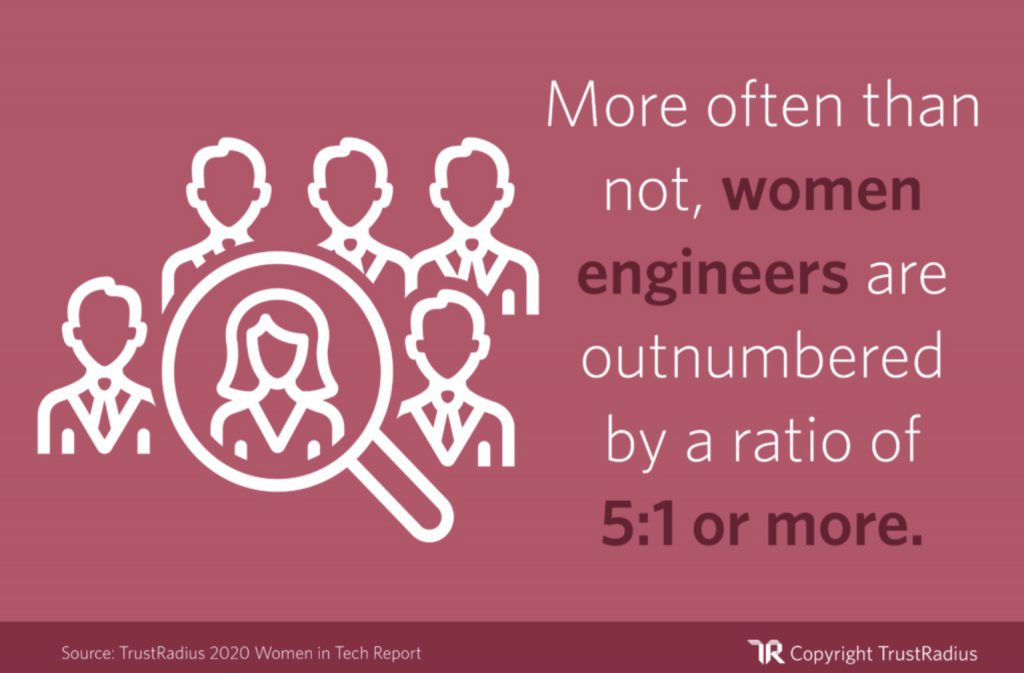
Now, here are the 5 tips for hiring for diversity and inclusion in tech:
1. Build a tech exclusionary list
Top tech companies have started creating their own internal style guides or setting internal goals to avoid using exclusionary language. For example:
- Amazon engineers have created an internal Wiki page that lists unconsciously biased terms and how to replace them in their everyday language. (source: Business Insider)
- Apple’s new coding terminology reflects its efforts to remove and replace non-inclusive language across Xcode, platform APIs, documentation, and open-source projects. (source: ZDNet)
- Twitter Engineering revealed new language that they’ll be using for coding terms, ditching old terms that are less inclusive. (source: Newsweek)
Inclusive language plays a critical role in fostering an environment where everyone belongs. At Twitter, the language we have been using in our code does not reflect our values as a company or represent the people we serve. We want to change that. #WordsMatter https://t.co/JVO8968B7K
— Twitter Engineering (@TwitterEng) July 2, 2020
Along with revamping programming language, creating bias-free job descriptions is key to inclusive hiring in tech. Ongig’s Text Analyzer flags biased terms that could make underrepresented groups feel excluded. Here are 2 examples:
The screenshot below shows a Data Scientist job description using the word “blacklisting” which is considered exclusionary to people of color in tech. Using more inclusive synonyms like the ones listed in the pop-up box removes bias that might make some people feel excluded.
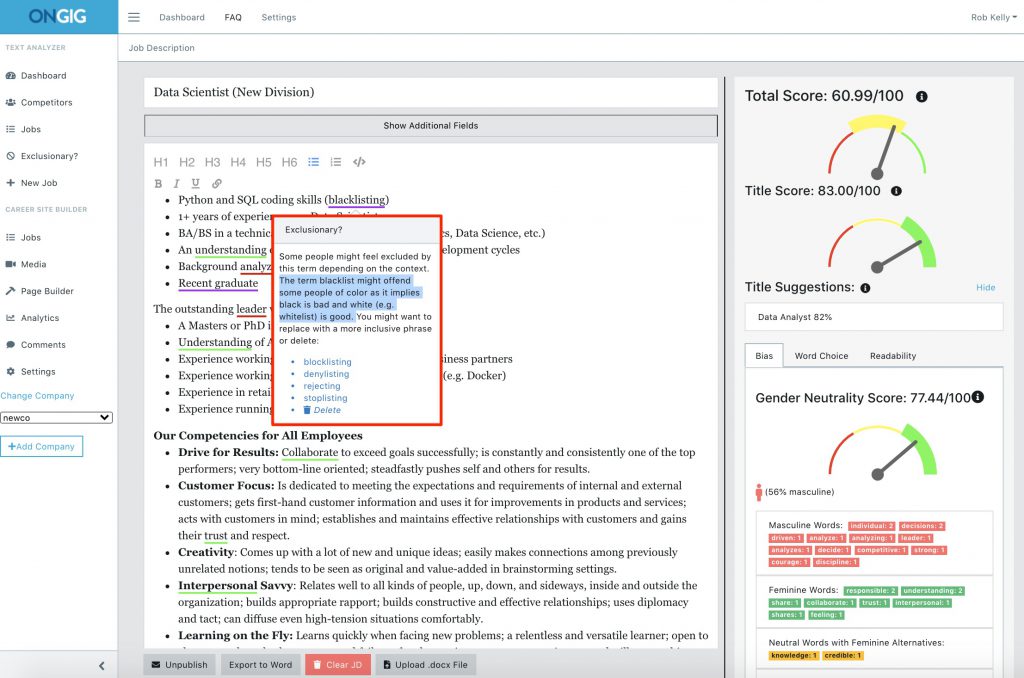
The Chief of Staff job description below shows masculine bias. Words like “competitive” can be replaced with words that do not contain gender bias towards women or women of color in tech.
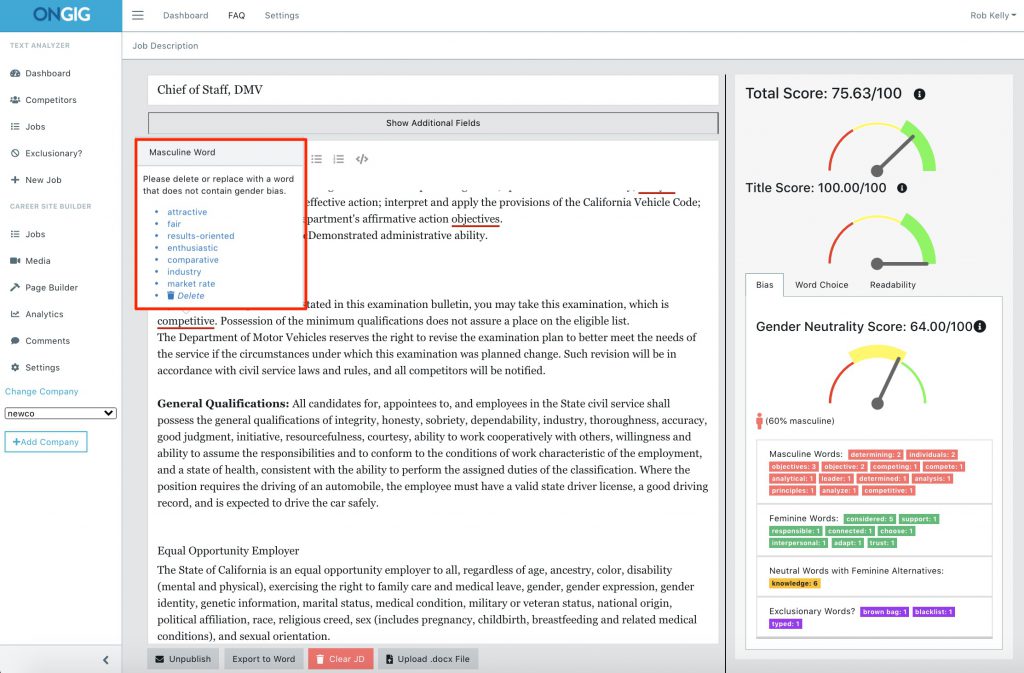
An article by Forbes on Achieving Workplace Diversity Through Recruitment In Tech says:
“It is also crucial to avoid gender-coded words like “guru,” “rockstar,” “aggressive” or “independent,” and look for collaborative team players instead with words like “dedicated,” “sociable” and “conscientious.” There is evidence that women are less attracted to terms that focus on competition as opposed to terms that depict commitment and support. The goal is to remove gender-biased terms in the hopes of increasing the applicant pool.”
Companies regularly modify their job descriptions to include language that supports inclusive hiring. According to Hacker Earth:
“Buffer uses its blog as a medium to explore issues in tech which affect underrepresented groups. The company also regularly modifies its job descriptions to include language and images that support inclusive hiring. They also sponsor awesome initiatives such as POCIT‘s Beer and Boardgames event and #wocintech‘s awesome photos.”
2. Set goals for recruiting diversity in engineering
Another idea is to set company-wide goals for hiring diversity in engineering. The companies below have invested dollars and set goals to hire more underrepresented groups in tech roles:
- Atlassian — lead an initiative to create more balanced technical teams.
- HubbleHQ — committed to actively reduce unconscious bias in their hiring process to bring more diverse people on board.
- Intel — donated $1.32 million to the “Growing the Legacy” scholarship, awarded to 40 Native American STEM students every year, and plans to increase the number of women in technical roles to 40% by 2030.
- Pinterest — committed to expanding their engineering roles to 30% held by women and 8% held by people from underrepresented ethnic groups.
- Siemens — invested more than $115 million in a pipeline of diverse STEM talent through workforce development initiatives.
(Editor’s note: For more company goals beyond diversity and inclusion in tech, check out 25+ Examples of Awesome Diversity Goals.)
How did Etsy recruit more women software engineers?
In 2011 Etsy only had 3 women engineers out of 47. So they invested in the goal of training junior women engineers through their Hacker School, in partnership with 37Signals and Yammer.
By 2013, Etsy’s engineering diversity increased by 500%, with an engineering team of 20 women and 90 men, according to FastCompany.
3. Use blind hiring tools for diversity hiring in tech
You can also increase diversity in engineering by using blind hiring tools. Companies that use tools that remove the potential for bias throughout the hiring process have a better chance of finding more diverse employees.
Tools like GapJumpers and Toggl Hire help companies to create skills-based assessments for candidates. An example of a GapJumpers “challenge” is pictured below. In this tool, candidates are ranked based on their performance, not on identifying factors, so hiring managers can choose who to interview based only on their performance.
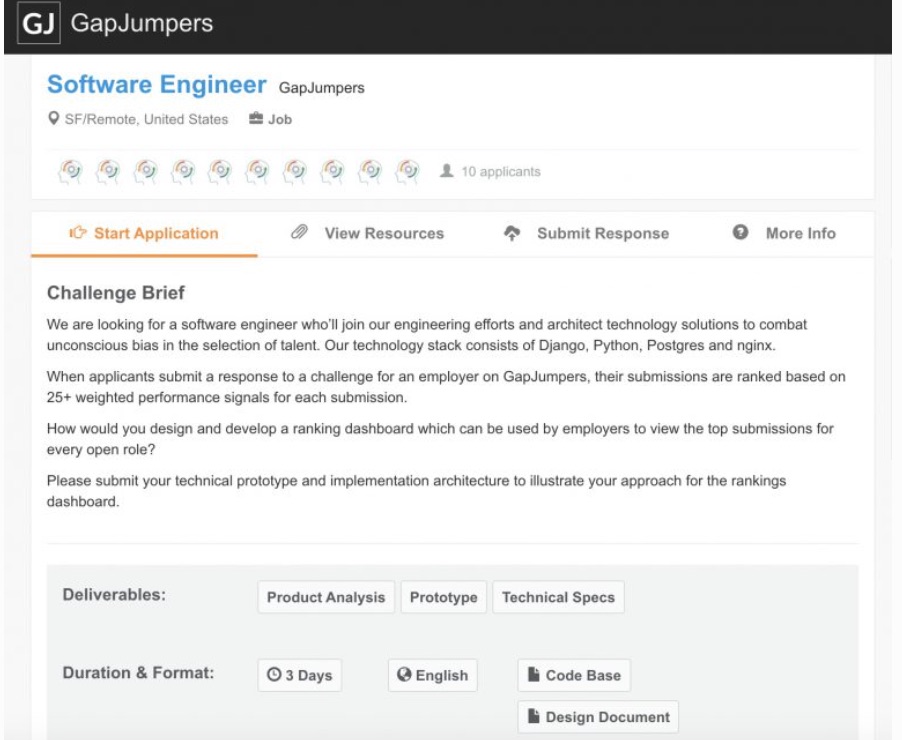
Tech talent is often on the spectrum or assumed to be, and many of the best engineers have ADHD. One of the world’s most famous autistic people, Temple Grandin, once said in an interview:
“Because autistic people think in pictures, they may be particularly good at technology.”
Giving neurodiverse candidates the opportunity to showcase their skills anonymously is often more valuable than an in-person interview. A recent virtual conference on Eliminating Bias from Hiring focused success with increasing neurodiversity in engineering roles by using skills-based hiring. Someone with autism or ADHD may not perform well in interviews but excel in a project designed around “real life” tasks for a job.
Here are a few famous tech leaders who are rumored to be neurodivergent:
- Steve Jobs
- Elon Musk
- Mark Zuckerberg
- Bill Gates
Companies like SAP, VMware, and JPMorgan Chase have also created dedicated programs for hiring people with autism, dyslexia, dyscalculia, ADHD, and Tourettes.
(Editor’s note: For a list of other famous people on the spectrum check out Famous People with Autism, Famous People with ADHD, and Famous People with Dyslexia.)
Other blind hiring tools like Pinpoint Recruitment, Blendoor, and Entelo remove details from a resume that could cause bias towards diverse engineers. Pinpoint Recruitment’s Blind Resume tool makes candidate resumes anonymous. The Pinpoint tool reads applicant data, then presents a redacted resume to the hiring manager. The screenshot below shows “Pink Peas” as an applicant and their personal data is hidden for the candidate screening process.
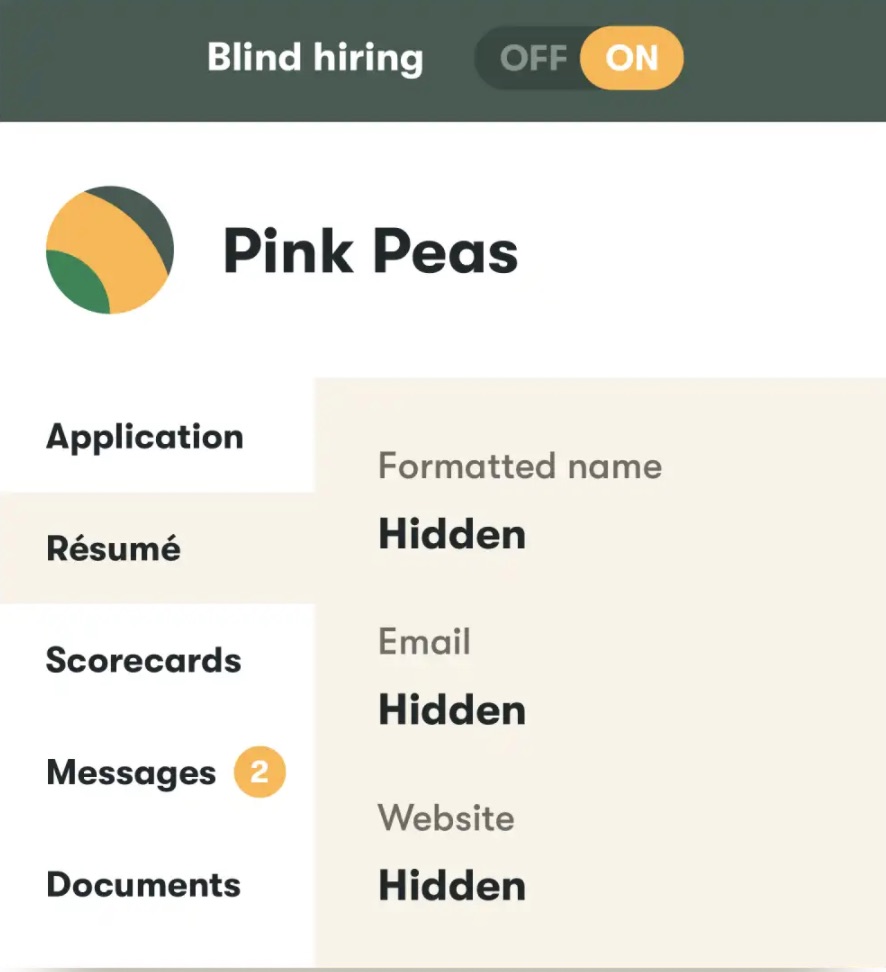
Removing unconscious bias creates more opportunities for hiring diversity in engineering. Companies like Dell also provide training to keep their employees accountable during the interview process.
A recent post from Codility on How Tech Companies are Paving the Way for Diversity in Engineering quoted Brian Reaves, Dell’s Chief Diversity and Inclusion Officer. Reaves said:
“We see tremendous opportunity to use technology to eliminate personal bias from how we recruit, to how we hire and promote.”
4. Recruit from coding camps/programs for engineering diversity
Recruiting from coding camps or programs focused on diversity recruiting in tech is another idea. One example of a company that has success with this is Slack. According to Hacker Earth:
“Since 2015, the company has proactively sought out candidates from outside traditional developer pipelines such as Stanford and MIT. It has also focused on recruiting tech talent from all women’s coding camps such as Hackbright and programs that focus on training black and Latino programmers such as Code2040.”
AngelList lists 41 Companies That Hire Coding Bootcamp Graduates on their website. A few companies on the list are:
- Greenhouse
- Vimeo
- Mixpanel
- Vroom
- PwC
Outside of coding camps and programs for engineering diversity. There are quite a few diversity recruitment websites that cater to diversity recruiting in tech. Arshiya Malik’s post on Medium lists some companies who are connecting employers to diverse pools of talent. Here are a few directly from Arshiya’s blog:
- Include.io: From the CEO of Lesbians Who Tech, Include.io is helping companies build their best teams by connecting them to underrepresented tech professionals looking to find their dream job and get hired for who they truly are.
- Lane: Created by Women 2.0 and with a strong focus on women in tech, Lane offers a connection point between high-quality tech talent and workplaces that care about making their companies more successful through inclusion.
- People of Color in Tech: A top recruitment platform that helps connect people of color with jobs in tech and startups.
- Women Who Code: Inspiring women to excel in technology careers, Women Who Code offers their members coding resources, scholarships, and access to a robust job board.
- 2050: A job site for people of color in creative, digital media and tech.
5. Highlight underrepresented groups on your career page
If you want to know how to find highly qualified diverse candidates in engineering, another idea is to highlight diversity in engineering on your career page.
Elastic’s dynamic career page, pictured below, showcases employee stories in a special section called “Someone Like Me”. One feature is a story from Liza Dayoub on women in open source.
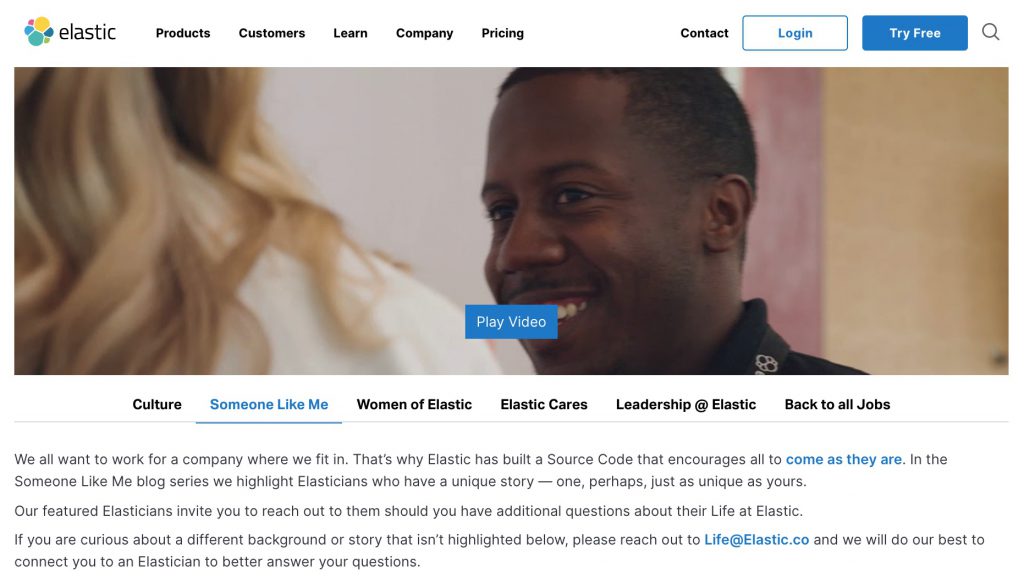

Tools like Ongig’s Career Site Builder make it easy for you to create custom microsites for diversity in the tech industry on your career page.
WHY I WROTE THIS
Ongig supports recruiting diversity in the tech industry. If you want to learn more about creating a dedicated diversity in tech page on your career site or analyze your job descriptions for bias request a demo to learn more.
Shout-Outs
- Five Years of Tech Diversity Reports—and Little Progress (by Sara Harrison)
- Someone Like Me (by Elastic)
- The state of ethnic minorities in U.S. tech: 2020 (by Galen Gruman)
- 2020 Women in Tech Report (by TrustRadius)
- 14 Companies With Standout – And Effective – Diversity Recruiting Strategies (by Danielle Agugliaro)
- Diversity in Tech: HubbleHQ’s Engineering Team Is Now 50% Female (by Hannah Watkins)
- How Etsy Attracted 500 Percent More Female Engineers (by Anna Kamenetz)
- The Go-Getter’s guide to diversity hiring in tech (by Soumya Chittigala)
- Achieving Workplace Diversity Through Recruitment In Tech (by Elaine Montilla)
- These 21 Companies are Connecting Employers to Diverse Pools of Talent (by Arshiya Malik)
- 41 Companies That Hire Coding Bootcamp Graduates (by AngelList)
- How Tech Companies are Paving the Way for Diversity in Engineering (by Arkady Zapesotsky)
- Amazon engineers built an internal wiki page that suggests alternatives to unconsciously racist terms like ‘brown bags,’ ‘cake walk,’ and ‘master/slave’
- Apple’s new style guide replaces non-inclusive language
- Engineers and Autism (by IEEE Spectrum)
